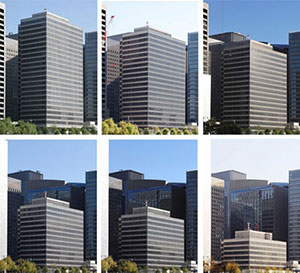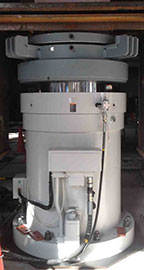Web Japan > Trends in Japan > Tech & Life > High-Tech Demolition Systems for High-Rises
High-Tech Demolition Systems for High-Rises
Safe & Environmentally Friendly Methods

The shrinking size of Akasaka Prince Hotel (Photo courtesy of Taisei Corp.)
Novel new high technology has been introduced to demolish high-rise buildings in Japan. Advanced demolition systems for high-rises feature safety, energy conservation and environmental protection. Skyscrapers are being constructed one after another all over the world as if countries are competing with one another for the height of buildings, and new construction systems are being introduced as well. In general, however, demolition work is still conducted in old-fashioned ways, crushed with heavy machines from top down and debris dropped to the ground with cranes. Buildings are sometimes even blasted into pieces with dynamite. The advanced demolishing methods Japan has developed are safe, efficient and even visually beautiful.
Shrinking Buildings
One of the new demolition methods was used to break down a 40-story building located near Akasaka, a Tokyo entertainment district. The building, a 140-meter steel-reinforced concrete structure, was used as a hotel that opened in 1983 and closed in March 2011 as its facilities became obsolete. Demolition is in full swing.
The newly introduced demolition system, called the "Taisei Ecological Reproduction System" (Tecorep System), has been developed by a major Japanese general contractor. Under the conventional system, a building is destroyed from top down with the roofless top left open. The Tecorep System, however, keeps the building as an enclosed space, retaining the roof of the top floor for cover. The outer circumference of the top floor is covered with soundproof panels so that noise and flying dust can be minimized.
The roof of the top floor is supported by 15 temporary columns, each 20 meters high, which are placed on giant beams two floors below. In the closed space, building components such as steel columns, beams and flooring are disassembled. Every time the two highest floors are dismantled, jacks incorporated into the columns are lowered, and the building becomes two floors lower as a whole. Seen from the outside, there is no way to know the building is being torn down and the building looks to be gradually shrinking, making it a mysterious demolition system.
Buildings That Generate Power

Under the Tecorep system, building components such as steel columns, beams and flooring are disassembled in the closed space. Every time the two highest floors are dismantled, jacks incorporated into the support columns are lowered, letting down both the roof and scaffolding, and the building becomes two floors lower.
Enlarge photoThe Tecorep System takes account of energy conservation as well as environmental protection, generating power during demolition work for use on the site, the first such method developed in the world.
Power is generated by a motor that runs on energy created when disassembled building components are lowered by crane through a hole punched in every floor. The electricity produced is stored in a battery. When a batch of components weighing five tons is lowered from the height of 100 meters, it generates about 100 kilowatts of electricity per hour. It is similar in principle to electric conversion of energy generated by applying the brakes on a train or a car or lowering a container load of goods at a port. The electricity generated is used for lighting on the site and other purposes.

The top floors of Akasaka Prince Hotel covered with scaffolding and soundproof panels as seen from the outside (left) and inside (right).
Enlarge photoMoreover, under the new method, temporary work to shield a building can be minimized, with the shielding materials needed reduced by more than 50%. The dismantling work in the closed environment can also decrease noise by 17-23 dB or more as compared with conventional methods.
Dust from conventional demolition work used to reach a radius of 200-300 meters, but the new dismantling method can reduce dust by as much as 90%. When dismantled with the use of cutters and other equipment making less noise than heavy machines, dust and noise can be reduced further.
Quake-proof Demolition Method

The shrinking height of a building captured in a series of "cut-and-down” photos: Before dismantling (top left), November 16, 2012 (top center), Nov. 27 (top right), Dec. 12 (bottom left), Dec. 19 (bottom center) and Jan. 8, 2013 (bottom right). (Photo courtesy of Kajima Corp.)
Enlarge photoUnlike the Tecorep System that dismantles buildings from top down, another demolition process, dubbed the "Kajima Cut and Take Down Method," has been developed to break buildings from bottom up for the first time in the world. Under this method, the shape of a building can be kept very much intact. The method is attracting a lot of attention because all dismantling work is conducted on the ground, resulting in not only reducing noise and dust but also dramatically improving the rate of recycling disassembled materials. The method has been developed since the 1990s by another major Japanese general contractor that recently successfully demolished a 108-meter, 24-story high-rise building using the system.
Columns of a floor were shortened by 80 cm, one by one, starting with the bottom floor, and each shortened column was propped up with a jack. In every round of "cut-and-down" dismantling, all columns were thus gradually cut and replaced with special jacks, each capable of holding 1,500 tons. After all columns of a floor were removed and replaced by jacks, the whole building was lowered by one floor. The method enabled a reduction in demolition time from nine months to six months and a half.
The method also shows a high level of resistance to earthquakes. Quake-resistant walls made of reinforced concrete, 40-90 cm in thickness and as high as three floors, are built inside a dismantled building in each phase of work, preventing being affected by tremor and strong wind. Under the method, the control center for demolition is hooked up with the Urgent Earthquake Detection and Alarm System via an optical fiber cable, keeping tabs on the building's load and maintaining anti-quake capability.
To reduce noise, a device known as Active Noise Control (ANC) was also tested. The device emits noise-canceling sonic waves of anti-phase wavelengths. Moreover, all materials dismantled from the building were segregated into groups inside the building compound according to a plan drawn up beforehand, resulting in a 90% improvement in the recycling rate.
Japan reportedly has about 800 buildings taller than 100 meters. About 150 of them are more than 20 years old and some of them are expected to be demolished for reasons such as low ceilings, susceptibility to earthquakes or redevelopment. Japan's construction companies are focusing as much on technological development for the demolition of high-rise buildings as on construction and maintenance. The Japanese technology, though developed to meet Japan's own needs, is expected to help demolish buildings abroad as well.
(March 2013)


